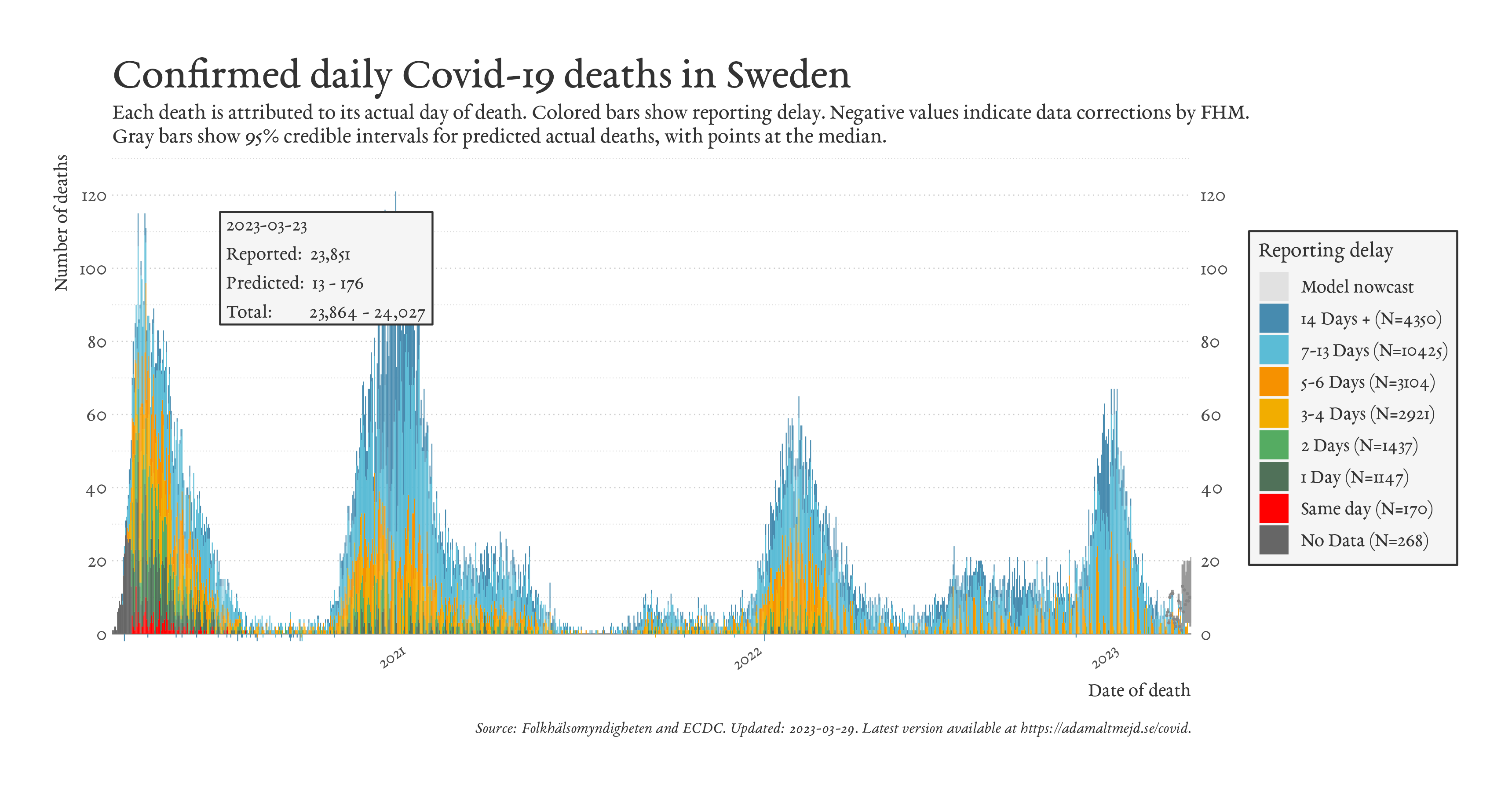SWECOV
The Covid-19 pandemic has profoundly impacted societies in ways we are only beginning to understand. I was part of the secretariat of Coronakommissionen, the Swedish corona commission, tasked by the government to evaluate the Swedish response. The Commission released its final report in February 2022, but together with Prof. Torsten Persson and Olof Östergren, I have initiated a large, 4-year, research program to continue our studies of the topic. More information about the Swedish Register-based Research Program on COVID-19 can be found on swecov.se.
COVID-19 Dashboard
Since mid April 2020, I have published a popular graphical dashboard of the Swedish death count. The Public Health Agency of Sweden publishes statistics by actual date of death. Most other countries only report newly added deaths, without information about when each person died. Since it often takes time for a death to be identified, this can be misleading. However, reporting death by death dates creates new problems. Mainly, the reporting delay means that recent days are not completed, which creates an illusion an always decreasing trend. To account for this, I added a graphical illustration of expected additional deaths. This later grew into a full-fledged nowcasting model documented in the paper below.
The Covid-19 dashboard is available at https://adamaltmejd.se/covid.
Publications
-
Inequality and COVID-19 in Sweden: Relative risks of nine bad life events, by four social gradients, in pandemic vs. prepandemic years
Proceedings of the National Academy of Sciences, 2023
with Olof Östergren, Evelina Björkegren, and Torsten Persson
The COVID-19 pandemic struck societies directly and indirectly, not just challenging population health but disrupting many aspects of life. Different effects of the spreading virus—and the measures to fight it—are reported and discussed in different scientific fora, with hard-to-compare methods and metrics from different traditions. While the pandemic struck some groups more than others, it is difficult to assess the comprehensive impact on social inequalities. This paper gauges social inequalities using individual-level administrative data for Sweden’s entire population. We describe and analyze the relative risks for different social groups in four dimensions—gender, education, income, and world region of birth—to experience three types of COVID-19 incidence, as well as six additional negative life outcomes that reflect general health, access to medical care, and economic strain. During the pandemic, the overall population faced severe morbidity and mortality from COVID-19 and saw higher all-cause mortality, income losses and unemployment risks, as well as reduced access to medical care. These burdens fell more heavily on individuals with low income or education and on immigrants. Although these vulnerable groups experienced larger absolute risks of suffering the direct and indirect consequences of the pandemic, the relative risks in pandemic years (2020 and 2021) were conspicuously similar to those in prepandemic years (2016 to 2019).
-
Nowcasting COVID-19 Statistics Reported with Delay: A Case-Study of Sweden and the UK
IJERPH, 2023
with Joacim Rocklöv and Jonas Wallin
The COVID-19 pandemic has demonstrated the importance of unbiased, real-time statistics of trends in disease events in order to achieve an effective response. Because of reporting delays, real-time statistics frequently underestimate the total number of infections, hospitalizations and deaths. When studied by event date, such delays also risk creating an illusion of a downward trend. Here, we describe a statistical methodology for predicting true daily quantities and their uncertainty, estimated using historical reporting delays. The methodology takes into account the observed distribution pattern of the lag. It is derived from the “removal method”—a well-established estimation framework in the field of ecology.
